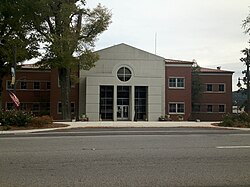2010 census
As of the census of 2010, there were 93,019 people, 35,810 households, and 25,328 families living in the county. The population density was 164 people per square mile (63 people/km2). There were 40,342 housing units at an average density of 71 units per square mile (27 units/km2). The racial makeup of the county was 87.6% White, 1.6% Black or African American, 0.8% Native American, 0.5% Asian, 0.1% Pacific Islander, 7.8% from other races, and 1.7% from two or more races. 12.1% of the population were Hispanic or Latino of any race. [14] Of the 35,810 households 30.3% had children under the age of 18 living with them, 53.4% were married couples living together, 12.1% had a female householder with no husband present, and 29.3% were non-families. 25.4% of households were one person and 11.4% were one person aged 65 or older. The average household size was 2.57 and the average family size was 3.05.
The age distribution was 25.0% under the age of 18, 8.58% from 18 to 24, 25.3% from 25 to 44, 26.0% from 45 to 64, and 14.9% 65 or older. The median age was 38.2 years. For every 100 females, there were 97.2 males. For every 100 females age 18 and over, there were 100.1 males.
The median household income was $37,661 and the median family income was $47,440. Males had a median income of $36,024 versus $27,478 for females. The per capita income for the county was $19,875. About 15.3% of families and 19.9% of the population were below the poverty line, including 30.3% of those under age 18 and 12.5% of those age 65 or over.
2000 census
As of the census of 2000, there were 82,231 people, 32,547 households, and 23,531 families living in the county. The population density was 145 people per square mile (56 people/km2). There were 36,331 housing units at an average density of 64 units per square mile (25 units/km2). The racial makeup of the county was 93.38% White, 1.47% Black or African American, 0.53% Native American, 0.24% Asian, 0.04% Pacific Islander, 3.24% from other races, and 1.09% from two or more races. 5.66% of the population were Hispanic or Latino of any race. [15] According to the census [16] of 2000, the largest ancestry groups in Marshall County were English 68.2%, Scots-Irish 12.31%, Scottish 5.1%, Irish 4.22%, Welsh 2.3% and African 1.47%.
Of the 32,547 households 32.40% had children under the age of 18 living with them, 57.80% were married couples living together, 10.70% had a female householder with no husband present, and 27.70% were non-families. 24.60% of households were one person and 10.90% were one person aged 65 or older. The average household size was 2.50 and the average family size was 2.96.
The age distribution was 24.90% under the age of 18, 8.50% from 18 to 24, 29.00% from 25 to 44, 23.40% from 45 to 64, and 14.20% 65 or older. The median age was 37 years. For every 100 females, there were 94.80 males. For every 100 females age 18 and over, there were 91.50 males.
The median household income was $32,167 and the median family income was $38,788. Males had a median income of $30,500 versus $20,807 for females. The per capita income for the county was $17,089. About 11.70% of families and 14.70% of the population were below the poverty line, including 17.90% of those under age 18 and 19.30% of those age 65 or over.






